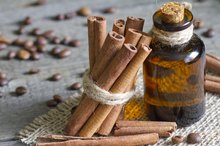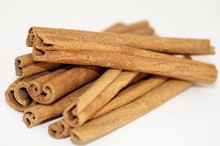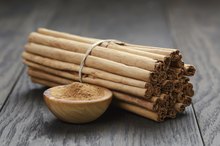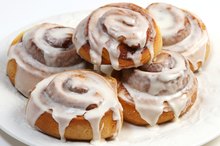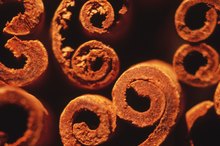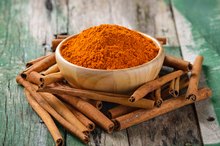What does fact checked mean?
At Healthfully, we strive to deliver objective content that is accurate and up-to-date. Our team periodically reviews articles in order to ensure content quality. The sources cited below consist of evidence from peer-reviewed journals, prominent medical organizations, academic associations, and government data.
The information contained on this site is for informational purposes only, and should not be used as a substitute for the advice of a professional health care provider. Please check with the appropriate physician regarding health questions and concerns. Although we strive to deliver accurate and up-to-date information, no guarantee to that effect is made.
Nutritional Information for Cinnamon Sticks
Cinnamon stick is the bark of a tropical tree, considered a spice 1. A stick is not artificially formed; it is a full sheet of this bark that naturally curls when fresh. This sweet spice has a variety of uses, and it also imparts a small amount of nutritional value. It contains some vitamins and minerals as well as healthy fatty acids. It is also naturally low in calories.
Calories and Calorie Breakdown
A 1-stick serving of cinnamon is quite low in calories 1. One cinnamon stick contains just 3 calories 1. If you follow a 2,000-calorie diet, the calories in this sweet spice account for 0.1 percent of the amount you may ingest in a 24-hour period. The majority of the calories in a cinnamon stick derive from carbohydrates, although a small portion comes from fat and protein 1. It’s not common to eat only a cinnamon stick; these are often grated to make ground cinnamon, used to stir fragrant beverages or broken into pieces for use in larger recipes, so your total caloric intake is likely to be greater 1.
Fats and Fatty Acids
Vitamins & Minerals in Cinnamon
Learn More
One cinnamon stick contains 0.02 gram of fat, only a trace amount 1. While cinnamon by itself is appropriate for a reduced-fat diet, it will not contribute greatly to the fat your body needs to function; aim to take in roughly 20 to 35 percent of your daily calories from fat 1. If you follow a 2,000-calorie diet, this amounts to 44 to 78 grams. Cinnamon sticks provide small amounts of essential fatty acids, which are healthy types of fats that may provide benefits for people with diabetes, cardiovascular disease or cognitive disorders 1. One cinnamon stick has 0.3 milligrams of omega-3 fatty acids and 1.1 milligrams of omega-6 fatty acids 1.
Carbohydrates and Fiber
Cinnamon sticks contain 1 gram of carbohydrates per stick 1. You require much more than this for a healthy diet with appropriate energy levels – 225 to 325 grams. One cinnamon stick provides a small amount of fiber as well, 0.7 grams 1. Consume 25 to 38 grams of fiber daily; this nutrient reduces your risk of developing constipation and diarrhea as well as more serious bowel problems.
Manganese
How Much Cinnamon Supplement to Take
Learn More
When you eat a cinnamon stick, you consume 11 percent of the manganese you should consume each day 1. Your body requires only small quantities of manganese, but it plays a critical role in your health. Without it, your blood might not clot correctly, and you have difficulty manufacturing sex hormones and metabolizing fat and carbohydrates.
Other Vitamins and Minerals
While cinnamon sticks are not a good source of vitamins and minerals other than their manganese content, you do get more than 1 percent of the daily recommended intake of calcium, useful for supplementing your diet with this bone-strengthening mineral 1. You also get roughly 0.5 percent of the iron and vitamin K you need every day.
Related Articles
References
- Food.com: Cinnamon
- USDA National Nutrient Database: Spices, Cinnamon, Ground
- Linus Pauling Institute; Essential Fatty Acids; J. Higdon, et al.; December 2005
- Rao PV, Gan SH. Cinnamon: A Multifaceted Medicinal Plant. Evid Based Complement Alternat Med. 2014;2014:642942. doi:10.1155/2014/642942
- Khan A, Safdar M, Ali Khan MM, Khattak KN, Anderson RA. Cinnamon Improves Glucose and Lipids of People With Type 2 Diabetes. Diabetes Care. 2003;26(12):3215-3218. doi:10.2337/diacare.26.12.3215
- Mollazadeh H, Hosseinzadeh H. Cinnamon effects on metabolic syndrome: a review based on its mechanisms. Iran J Basic Med Sci. 2016;19(12):1258-1270. doi:10.22038/IJBMS.2016.7906
- Gruenwald J, Freder J, Armbruester N. Cinnamon and Health. Crit Rev Food Sci Nutr. 2010;50(9):822-834. doi:10.1080/10408390902773052
- Goel N, Rohilla H, Singh G, Punia P. Antifungal Activity of Cinnamon Oil and Olive Oil against Candida Spp. Isolated from Blood Stream Infections. J Clin Diagn Res. 2016;10(8):DC09-11. doi:10.7860/JCDR/2016/19958.8339
- Murali MR, Naveen SV, Son CG, Raghavendran HRB. Current knowledge on alleviating infections through the use of some commonly known natural products: bench to bedside. Integr Med Res. 2014;3(3):111-118. doi:10.1016/j.imr.2014.04.001
- Hawrelak JA, Myers SP. Effects of Two Natural Medicine Formulations on Irritable Bowel Syndrome Symptoms: A Pilot Study. J Altern Complement Med. 2010;16(10):1065-1071. doi:10.1089/acm.2009.0090
- Walanj S, Walanj A, Mohan V, Thakurdesai PA. Efficacy and safety of the topical use of intranasal cinnamon bark extract in seasonal allergic rhinitis patients: A double-blind placebo-controlled pilot study. Journal of Herbal Medicine. 2014;4(1):37-47. doi:10.1016/j.hermed.2013.12.002
- Connolly M, Axtell A, Hickey S, et al. Chemical Burn From Cinnamon Oil. Eplasty. 2017;17:ic11.
Resources
Writer Bio
Nicki Wolf has been writing health and human interest articles since 1986. Her work has been published at various cooking and nutrition websites. Wolf has an extensive background in medical/nutrition writing and online content development in the nonprofit arena. She graduated with a Bachelor of Arts in English from Temple University.
